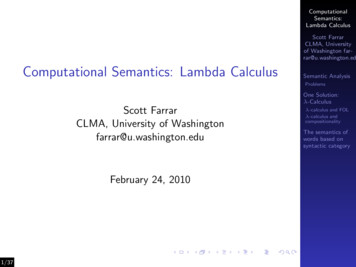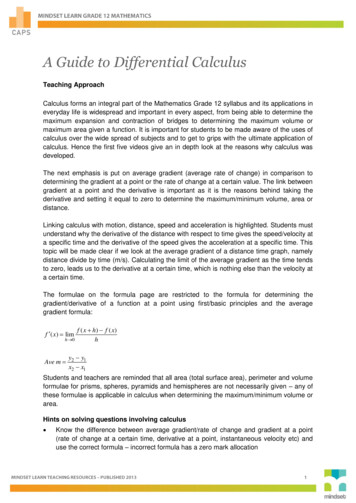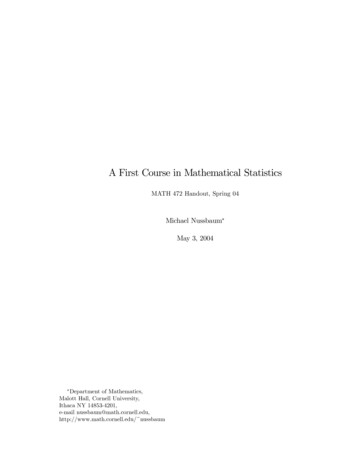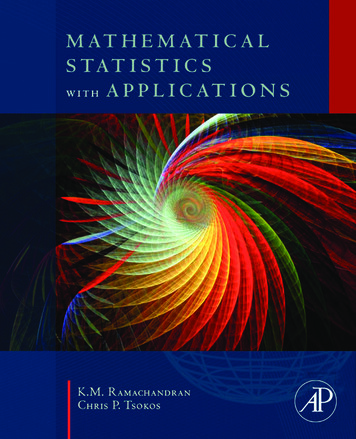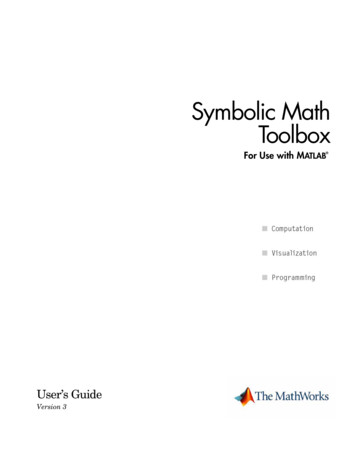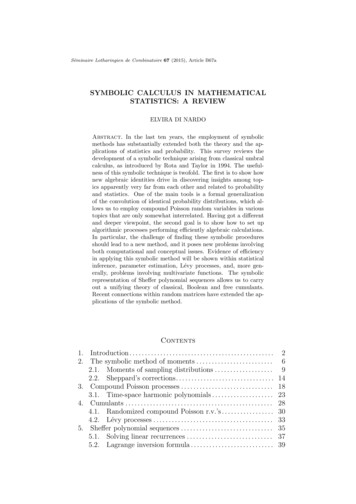
Transcription
Séminaire Lotharingien de Combinatoire 67 (2015), Article B67aSYMBOLIC CALCULUS IN MATHEMATICALSTATISTICS: A REVIEWELVIRA DI NARDOAbstract. In the last ten years, the employment of symbolicmethods has substantially extended both the theory and the applications of statistics and probability. This survey reviews thedevelopment of a symbolic technique arising from classical umbralcalculus, as introduced by Rota and Taylor in 1994. The usefulness of this symbolic technique is twofold. The first is to show hownew algebraic identities drive in discovering insights among topics apparently very far from each other and related to probabilityand statistics. One of the main tools is a formal generalizationof the convolution of identical probability distributions, which allows us to employ compound Poisson random variables in varioustopics that are only somewhat interrelated. Having got a differentand deeper viewpoint, the second goal is to show how to set upalgorithmic processes performing efficiently algebraic calculations.In particular, the challenge of finding these symbolic proceduresshould lead to a new method, and it poses new problems involvingboth computational and conceptual issues. Evidence of efficiencyin applying this symbolic method will be shown within statisticalinference, parameter estimation, Lévy processes, and, more generally, problems involving multivariate functions. The symbolicrepresentation of Sheffer polynomial sequences allows us to carryout a unifying theory of classical, Boolean and free cumulants.Recent connections within random matrices have extended the applications of the symbolic method.Contents1. Introduction . . . . . . . . . . . . . . . . . . . . . . . . . . . . . . . . . . . . . . . . . . . . . . .2. The symbolic method of moments . . . . . . . . . . . . . . . . . . . . . . . . .2.1. Moments of sampling distributions . . . . . . . . . . . . . . . . . . .2.2. Sheppard’s corrections. . . . . . . . . . . . . . . . . . . . . . . . . . . . . . . .3. Compound Poisson processes . . . . . . . . . . . . . . . . . . . . . . . . . . . . . .3.1. Time-space harmonic polynomials . . . . . . . . . . . . . . . . . . . .4. Cumulants . . . . . . . . . . . . . . . . . . . . . . . . . . . . . . . . . . . . . . . . . . . . . . . .4.1. Randomized compound Poisson r.v.’s . . . . . . . . . . . . . . . . .4.2. Lévy processes . . . . . . . . . . . . . . . . . . . . . . . . . . . . . . . . . . . . . . .5. Sheffer polynomial sequences . . . . . . . . . . . . . . . . . . . . . . . . . . . . . .5.1. Solving linear recurrences . . . . . . . . . . . . . . . . . . . . . . . . . . . .5.2. Lagrange inversion formula . . . . . . . . . . . . . . . . . . . . . . . . . . .269141823283033353739
2ELVIRA DI NARDO5.3.6. Fast6.1.6.2.Generalized Bell polynomials . . . . . . . . . . . . . . . . . . . . . . . . .symbolic computation . . . . . . . . . . . . . . . . . . . . . . . . . . . . . . . .k-statistics and polykays . . . . . . . . . . . . . . . . . . . . . . . . . . . . .Computing cumulants through generalized Abelpolynomials . . . . . . . . . . . . . . . . . . . . . . . . . . . . . . . . . . . .7. Multivariate Faà di Bruno formula . . . . . . . . . . . . . . . . . . . . . . . . .7.1. Multivariate cumulants . . . . . . . . . . . . . . . . . . . . . . . . . . . . . . .7.2. Multivariate Lévy processes . . . . . . . . . . . . . . . . . . . . . . . . . .7.3. Multivariate Hermite polynomials. . . . . . . . . . . . . . . . . . . .7.4. Multivariate Bernoulli polynomials. . . . . . . . . . . . . . . . . . .8. Appendix 1: Tables of computation times . . . . . . . . . . . . . . . . . .9. Appendix 2: Families of time-space harmonic polynomials .10. Acknowledgments . . . . . . . . . . . . . . . . . . . . . . . . . . . . . . . . . . . . . . . .References . . . . . . . . . . . . . . . . . . . . . . . . . . . . . . . . . . . . . . . . . . . . . . . . . . . . .404142465357585961626467671. IntroductionMost practical problems do not have exact solutions, but numericalcomputing helps in finding solutions to desired precision. Numericalmethods give data that can be analyzed to reveal trends or approximations. In contrast to numerical methods, symbolic methods treatobjects that are either formal expressions, or are algebraic in nature.In many cases, numerical methods will not give sufficient informationabout the nature of the problem; this is where symbolic methods fit in.When used properly, they can give us more insight into the problemwe are trying to solve. Another advantage is that, while numericalmethods may simply fail to compute correct results, symbolic methodsyield closed or explicit formulas. Although the term “symbolic method”is also used in different contexts (see for example [42]), here we referto a set of manipulation techniques aimed at performing algebraic calculations, preferably through an algorithmic approach, in order to findefficient mechanical processes that may be passed to a computer. Thisis usually called “symbolic computation”. Despite the fact that itsdevelopment took place later than that of numerical or graphical algorithms, symbolic computation has had a comparable impact, especiallyin theoretical and applied statistical research. Topics range from asymptotic expansions to Edgeworth series, from likelihood functions tosaddlepoint approximations.Since symbolic computation is exact, its accuracy is not a fundamental issue, as it is for numerical methods. Replacing pencil and paperby a computer is not the only aim of symbolic methods. Computational cost is a question naturally arising when problems of complexnature are addressed. The advantage of symbolic methods is that, by
SYMBOLIC CALCULUS IN MATHEMATICAL STATISTICS3approaching a problem from a different mathematical point of view,efficiency is sometimes a by-product.The symbolic method we are going to review arises from the socalled “classical umbral calculus”, a creation of Gian-Carlo Rota, whospent most of his scientific life looking for an elegant and as general aspossible formalization of this calculus.It is certainly due to Rota’s efforts that the heuristic method, invented and largely employed by Rev. John Blissard between 1861 and1868 (see references in [33]), now has a solid foundation and widespread application within the mathematical community. Despite theimpressive amount of scientific literature following the introduction ofthis calculus, Rota, in 1994, had the courage to turn his umbral calculus upside down, outlining what he considered to be a new and correctsyntax for this matter. The classical umbral calculus we use consistsessentially in a moment calculus, since its basic device is to representa unital sequence of numbers by symbols α, called umbra, i.e., to associate the sequence 1, a1 , a2 , . . . to the sequence 1, α, α2 , . . . of powers ofα via an operator E that looks like the expectation of random variables(r.v.’s) [35, 75]. The i-th element of the sequence is then called the ith moment of α. This symbolic approach shares with free probability[58, 90] the use of moments as a tool to characterize r.v.’s. An analogof freeness1 is defined in a manner resembling independence of tensors.In contrast to free probability, where different linear operators maybe applied to the same non-commutative r.v., in the symbolic methodof moments just one operator is employed, but the same sequence ofmoments may correspond to more than one symbol. For a pair of commutative r.v.’s, freeness is equivalent to at least one of them havingvanishing variance. So freeness is a pure non-commutative device, andthe symbolic approach we are going to review can be considered as thenatural analog of a non-commutative field.“As sometimes happens in the practice of the mathematical investigation, the subject we deal with here does not develop the original ideafrom which our research started in the spring of 1997, but this paperis closely related to it. In that period, Gian-Carlo Rota was visitingprofessor at the University of Basilicata and, during a conversation justbefore he left, he shared with us his keen interest in a research project:to develop a combinatorial random variable theory. The delicate question arising on the underlying foundational side and the short timeavailable led us to continue the discussion via email, weaving it withdifferent activities over a period of several months. The following year,Gian-Carlo Rota held his last course in Cortona; we seized the opportunity to spend some time with him. We resumed the thread of ourconversations and presented him with the doubts that gradually tookhold of us. As usually, his contribution disclosed new horizons that1Infree probability, free r.v.’s correspond to classical independent r.v.’s.
4ELVIRA DI NARDOhave led us to write these pages.” This quotation is a part of the introduction of the paper “Umbral nature of the Poisson random variables”written by the author together with Domenico Senato and publishedin a volume dedicated to Gian-Carlo Rota after his death [33]. Thispaper was the first of a substantial list of articles devoted to the applications of classical umbral calculus in probability and statistics. Inthese papers, more definitions have been added, and the method hasbeen restyled according to the needs faced when tackling some particular problems. The more these new tools have been developed, the closerthe method has come to the method of moments employed in the studyof random matrices, which the author believes to be a natural milestoneof this theory and at the same time a good starting point for furtherdevelopments and applications. This is why the version here reviewedis called symbolic method of moments in a talk [18] on new challengesand future developments of mathematical statistics given by the authorin Dublin in 2011. Two papers have to be mentioned in support of thispersonal belief: a paper published in the Annals of Statistics devotedto the computation of spectral statistics for random matrices [26] anda second one, published in the Journal of Multivariate Analysis, wherethe symbolic method of moments allows us to compute very generaljoint moments of non-central Wishart distributions [19]. The authorchose to not include these topics in this review, since the overall settingis not yet completely settled, and a serious rethinking of the matter interms of cumulants2 instead of moments seems necessary.The first goal of this paper is to give a general overview of how themethod has been developed and where it has been used with success.While sticking to the original idea, the current version of the methodoffers a much richer set of tools. Therefore the introduction of thesetools is done gradually along the paper according to the outline ofapplications. The second goal is to prove its effectiveness in someapplications that over the years have contributed to refining the theory.An example particularly meaningful is the computation of k-statistics(Section 6.1), a challenging problem since their first introduction in1929 as unbiased estimators of cumulants [41]. Many authors haveproposed different techniques aiming at performing this computationin a reasonable time. By using the symbolic method here reviewed, anefficient computation of k-statistics can be performed by means of asuitable generalization of randomized compound Poisson r.v.’s.The paper is organized as follows. Notation is introduced in Section 2 using the semantics of r.v.’s. In this way, the intention is topermit the reader with no prior knowledge of symbolic calculationsto become comfortable with them. Section 2.1 shows how to performthese computations in dealing with moments of sampling distributions,2Forthe definition of cumulants of a number sequence, see Section 4 and inparticular Equation (4.1).
SYMBOLIC CALCULUS IN MATHEMATICAL STATISTICS5reducing the underlying combinatorics of symmetric functions to a fewrelations covering a great variety of calculations. Section 2.2 is devotedto a special statistical device, called Sheppard’s correction, useful incorrecting estimations of moments when sample data are grouped intoclasses. The resulting closed-form formula gives an efficient algorithmto perform computations. In the same section, its multivariate versionis sketched, showing what we believe is one of the most interestingfeature of this symbolic method: its multivariate generalization. Moredetails are given in Section 7, where a symbolic version of the multivariate Faà di Bruno formula is also introduced. The umbral calculusis particularly suited not only in dealing with number sequences, butalso with polynomial sequences. Time-space harmonic polynomials arean example in which the symbolic method allows us to simplify theproofs of many properties, as well as their computation. Introduced inSection 3, these polynomials generate stochastic processes that resultin a special family of martingales employed in mathematical finance.Time-space harmonic polynomials rely on the symbolic representationof Lévy processes, as given in Section 4.2, obtained by using a generalization of compound Poisson processes, as given in Section 4.1. A Lévyprocess is better described by its cumulant sequences than by its moments, as happens for many other r.v.’s, the Gaussian or the Poissonr.v.’s. Section 4 is devoted to introducing umbrae whose moments arecumulants of a given sequence of numbers. Besides classical cumulants,quite recently [90] new families of cumulants have been introduced, theBoolean and the free cumulants by using the algebra of multiplicative functions on suitable lattices. This link is exploited in Section 6.2,where the computational efficiency of the symbolic method of momentsis highlighted. In particular, by means of the symbolic representationof Abel polynomials, all families of cumulants can be parametrized bythe same formula. This parametrization allows us to write an algorithmgiving moments in terms of classical, Boolean and free cumulants, andvice-versa. Other topics on Sheffer sequences are treated in Section 5,including Lagrange inversion and Riordan arrays, and solutions of difference equations. Section 6.1 shows how to compute unbiased estimators of cumulants by using exponential polynomials, which are specialSheffer sequences. The resulting algorithm is faster than others givenin the literature, and it has been generalized to the multivariate case.In the last section, the multivariate umbral calculus is introduced, andvarious applications are given involving special families of multivariatepolynomials.This text is the written version of lectures given at the 67-th Seminaire Lotharingien de Combinatoire in September 2011; joint sessionwith XVII Incontro Italiano di Combinatoria Algebrica. Due to thelength and to avoid making dull reading, the formalism is kept to the
6ELVIRA DI NARDOminimum, and references are given step by step for those wishing to gointo details and to understand the technical proofs of formal matters.2. The symbolic method of momentsThe method we are going to introduce in this section consists ofshifting powers ai to indexes ai by using a linear functional. The ideaof dealing with subscripts as they were powers was extensively used bythe mathematical community since the nineteenth century, althoughwith no rigorous foundation. The method, sometimes called Blissard’ssymbolic method, is often attributed to J. Sylvester. He was the firstwho introduced the term umbral from latin to denote the shadowytechniques used to prove certain polynomial equations. Roman andRota have equipped these “tricks” with the right formalism in 1978,by using the theory of linear operators [71]. Despite the impressiveamount of applications following this rigorous foundation (see references in [33]), in 1994 Rota proposed a new version of the method ina paper entitled “The classical umbral calculus” [75]. The reason ofthis rethinking is well summarized in the following quotation [75]: “Although the notation of Hopf algebra satisfied the most ardent advocateof spic-and-span rigor, the translation of classical umbral calculus intothe newly found rigorous language made the method altogether unwieldy and unmanageable. Not only was the eerie feeling of witchcraftlost in the translation, but, after such a translation, the use of calculus to simplify computation and sharpen our intuition was lost bythe wayside.” The term classical is strictly related to which sequenceis chosen as the unity of the calculus. Rota has always referred to thesequence {1}, and the same is done in the version we are going to introduce, that from now on will be called symbolic method of moments.Let R be the real field3. The symbolic method of moments consists ofa set A {α, γ, . . .} of elements called umbrae, and a linear functionalE : R[A ] R, called evaluation, such that E[1] 1 and(2.1)E[αi γ j · · · ] E[αi ]E[γ j ] · · · (uncorrelation property)for non-negative integers i, j, . . .Definition 2.1. [33] The sequence {1, a1 , a2 , . . .} R is said to be umbrally represented by an umbra α if E[αi ] ai for all positive integers i.In the following, in place of {1, a1 , a2 , . . .} we will use the notation{ai }i 0 assuming a0 1. Special umbrae are given in Table 1.3Theumbral calculus given in [75] considers a commutative integral domainwhose quotient field is of characteristic zero. For the applications given in thefollowing, the real field R is sufficient.4The i-th Bell number is the number of partitions of a finite non-empty set with ielements or the i-th coefficient times i! in the Taylor series expansion of the functionexp(et 1).
SYMBOLIC CALCULUS IN MATHEMATICAL STATISTICS7Table 1. Special umbraeUmbraeAugmentation umbraUnity umbraSingleton umbraBell umbraBernoulli umbraEuler umbraMoments for positive integers iE[εi ] 0E[ui ] 1E[χi ] δi,1 , the Kronecker deltaE[β i ] Bi , the i-th Bell number4E[ιi ] Bi , the i-th Bernoulli number5E[ξ i ] Ei , the i-th Euler number6Associating a measure with a sequence of numbers is familiar inprobability theory, when the i-th term of a sequence can be consideredas the i-th moment of a r.v., under suitable hypotheses (the so-calledHamburger moment problem [94]). As Rota underlines in Problem 1:the algebra of probability [73], all of probability theory could be donein terms of r.v.’s alone by taking an ordered commutative algebra overthe reals, and endowing it with a positive linear functional. Followingthis analogy, ai is called the i-th moment of the umbra α.Definition 2.2. A r.v. X is said to be represented by an umbra α ifits sequence of moments {ai }i 0 is umbrally represented by α.In order to avoid misunderstandings, the expectation of a r.v. X willbe denoted by E, and its i-th moment by E[X i ].Example 2.3. If P (X 0) 1, the r.v. X is represented by theaugmentation umbra ε. If P (X 1) 1, the r.v. X is represented bythe unity umbra u. The Poisson r.v. Po(1) of parameter 1 is representedby the Bell umbra β. More examples of umbrae representing classicalr.v.’s can be found in [28].Not all r.v.’s can be represented by umbrae. For example, the Cauchyr.v. does not admit moments. Moreover, not all umbrae represent r.v.’s.For example, the singleton umbra in Table 1 does not represent a r.v.since its variance is negative E[χ2 ] E[χ]2 1, even though this umbra will play a fundamental role in the whole theory. If {ai }i 0 , {gi }i 0and {bi }i 0 are sequences umbrally represented by the umbrae α, γ andζ, respectively, then the sequence {hi }i 0 with Xihi ak1 gk2 · · · bkmk1 , k2 , . . . , kmk k ··· k i15Many2mcharacterizations of Bernoulli numbers can be found in the literature, andeach one may be used to define these numbers.Here we refer to the sequence of Pinumbers satisfying B0 1 and k 0 i 1B 0for i 1, 2, . . . .kk6The Euler numbers are the coefficients of the formal power series 2ez /[e2z 1].
8ELVIRA DI NARDOis umbrally represented by α γ · · · ζ , that is, {z}m(2.2)E[(α γ · · · ζ ) ] {z} m Xik1 k2 ··· km i iak1 gk2 · · · bkm .k1 , k2 , . . . , kmThe right-hand side of Equation (2.2) represents the i-th moment of asummation of independent r.v.’s.The second fundamental device of the symbolic method of momentsis to represent the same sequence of moments by different umbrae.Definition 2.4. Two umbrae α and γ are said to be similar if andonly if E[αi ] E[γ i ] for all positive integers i. In symbols α γ.If we replace the set {α, γ, . . . , ζ} by a set of m distinct and similarumbrae {α, α0 , . . . , α00 }, Equation (2.2) givesX000 i(m)νλ dλ aλ ,)] (2.3)E[(α α ··· α{z} λ imwhere the summation is over all partitions7 λ of the integer i, aλ a1r1 ar22 · · · andi!dλ rr12(1!) (2!) · · · r1 ! r2 ! · · ·is the number of i-set partitions with block sizes given by the partsof λ. The new symbol m.α denotes the summation α α0 · · · α00and is called dot-product of m and α. This new symbol is referredto as auxiliary umbra, in order to underline that it is not in A . SoEquation (2.3) may be rewritten asX(2.4)E[(m.α)i ] (m)νλ dλ aλ .λ iThe introduction of new symbols is not only a way of lightening notation, but also to represent sequences of moments obtained by suitablegeneralizations of the right-hand side of Equation (2.4). This will become clearer as we move along further. According to Definition 2.2,the auxiliary umbra m.α represents a summation of m independentand identically distributed (i.i.d.) r.v.’s. Indeed, identically distributedr.v.’s share the same sequence of moments, if they have.If we denote by X the alphabet of auxiliary umbrae, the evaluationE may be defined using the alphabet A X , and so we can deal withauxiliary umbrae as they were elements of the base alphabet [75]. In7Recallthat a partition of an integer i is a sequence λ (λ1 , λ2 , . . . , λt ), wherePtλj are weakly decreasing integers and j 1 λj i. The integers λj are called partsof λ. The length of λ is the number of its parts and will be indicated by νλ . Adifferent notation is λ (1r1 , 2r2 , . . .), where rj is the number of parts of λ equalto j and r1 r2 · · · νλ . We use the classical notation λ i to denote that “λis a partition of i”.
SYMBOLIC CALCULUS IN MATHEMATICAL STATISTICS9the following, we still refer to the alphabet A as the overall alphabetof umbrae, assuming that auxiliary umbrae are included.Summations of i.i.d.r.v.’s appear in many sample statistics. So thefirst application we give in statistics concerns sampling distributions.2.1. Moments of sampling distributions. It is recognized that anappropriate choice of language and notation can simplify and clarifymany statistical calculations [54]. In managing algebraic expressionssuch as the variance of sample means, or, more generally, moments ofsampling distributions, the main difficulty is the manual computation.Symbolic computation has removed many of such difficulties. The needof efficient algorithms has increased the attention on how to speed upthe computational time. Many of these algorithms rely on the algebraof symmetric functions [1]: U -statistics are an example which arisenaturally when looking for minimum-variance unbiased estimators. AU -statistic of a random sample has the form1 X(2.5)U Φ(Xj1 , Xj2 , . . . , Xjk ),(n)kwhere X1 , X2 , . . . , Xn are n independent r.v.’s, and the sum rangesover the set of all permutations (j1 , j2 , . . . , jk ) of k integers chosen in[n] : {1, 2, . . . , n}. If X1 , X2 , . . . , Xn are identically distributed r.v.’swith common cumulative distribution function F (x), U is an unbiasedestimator of the population parameterZ ZZΘ(F ) · · · Φ(x1 , x2 , . . . , xk ) dF (x1 ) dF (x2 ) · · · dF (xk ).In this case, the function Φ may be assumed to be a symmetric functionof its arguments. Often, in applications, Φ is a polynomial in theXj ’s, so that U -statistics are symmetric polynomials. By virtue of thefundamental theorem of symmetric polynomials, U -statistics can beexpressed in terms of elementary symmetric polynomials. The symbolicmethod proposed here provides a way to find this expression [22].The starting point is to replace R by R[x1 , x2 , . . . , xn ], where x1 , x2 ,. . . , xn are indeterminates. This device allows us to deal with multivariable umbral polynomials p R[x1 , x2 , . . . , xn ]. The uncorrelationproperty (2.1) is then updated toE[xki 1 xkj 2 · · · αk3 γ k4 · · · ] xki 1 xkj 2 · · · E[αk3 ]E[γ k4 ] · · ·for any set of distinct umbrae in A , for i, j [n], with i 6 j, and forall positive integers k1 , k2 , k3 , k4 .For umbral polynomials p, q R[x1 , x2 , . . . , xn ][A ], we may relax thesimilarity equivalence and introduce another umbral equivalence:p'qif and only if E[p] E[q].
10ELVIRA DI NARDOA polynomial sequence {pi }i 0 R[x1 , x2 , . . . , xn ], with p0 1 anddegree(pi ) i, is represented by an umbra ψ, called polynomial umbra, if E[ψ i ] pi for all positive integers i. The classical bases of thealgebra of symmetric polynomials can be represented by polynomialumbrae [21]. For example, the i-th elementary symmetric polynomialei (x1 , x2 , . . . , xn ) satisfies(χ1 x1 χ2 x2 · · · χn xn )i, for i n,i!with χ1 , χ2 , . . . , χn uncorrelated singleton umbrae. If the indeterminates x1 , x2 , . . . , xn are replaced by n uncorrelated umbrae α1 , α2 , . . . ,αn similar to an umbra α, then Equivalence (2.6) becomes(2.6)ei (x1 , x2 , . . . , xn ) '[n.(χα)]i, for i n.i!The umbral polynomial ei (α1 , α2 , . . . , αn ) is called the i-th umbral elementary symmetric polynomial. The umbrae {α1 , α2 , . . . , αn } in (2.7)may also be replaced by some powers such as {α1j , α2j , . . . , αnj }. Let usconsider the monomial symmetric polynomialXmλ (x1 , x2 , . . . , xn ) xλ1 1 xλ2 2 · · · xλnnei (α1 , α2 , . . . , αn ) '(2.7)with λ i n, where the notation is symbolic and must be interpretedin the way that all different images of the monomial xλ1 1 xλ2 2 · · · xλnn underpermutations of the variables have to be summed. If the indeterminatesx1 , x2 , . . . , xn are replaced by n uncorrelated umbrae α1 , α2 , . . . , αn similar to an umbra α, then(2.8)mλ (α1 , α2 , . . . , αn ) '[n.(χα)]r1 [n.(χα2 )]r2··· ,r1 !r2 !which is a product of umbral elementary polynomials in (2.7). In manystatistical calculations, the so-called augmented monomial symmetricpolynomials [94] are involved:m̃λ (x1 , x2 , . . . , xn ) Xxj1 · · · xjr1 x2jr1 1 · · · x2jr1 r2 · · · .j1 6 .6 jr1 6 jr1 1 6 .6 jr1 r2 6 ···These polynomials are obtained from mλ (x1 , x2 , . . . , xn ) as follows:(2.9)mλ (x1 , x2 , . . . , xn ) m̃λ (x1 , x2 , . . . , xn ).r1 !r2 ! · · ·Then, from Equivalence (2.8) and Equation (2.9), we have(2.10)m̃λ (α1 , α2 , . . . , αn ) ' [n.(χα)]r1 [n.(χα2 )]r2 · · · ,which is again a product of umbral elementary polynomials (2.7).
SYMBOLIC CALCULUS IN MATHEMATICAL STATISTICS11Example 2.5. If λ (12 , 3) and n 5 then[n.(χα)]2 [n.(χα3 )] (χ1 α1 · · · χn αn )2 (χ1 α13 · · · χn αn3 )!!XXX χj3 αj33 'αj1 αj2 αj33 .χj1 αj1 χj2 αj21 j3 n1 j1 6 j2 n1 j1 6 j2 6 j3 nThis last equivalence follows by observing that E[χj1 χj2 χj3 ] vanisheswhenever there is at least one pair of equal indices among {j1 , j2 , j3 }.More details on symmetric polynomials and polynomial umbrae aregiven in [21]. Due to Equivalence (2.10), the fundamental expectationresult, at the core of unbiased estimation of moments, may be restatedas follows.Theorem 2.6. [21] If λ (1r1 , 2r2 , . . .) i n, then E [n.(χα)]r1 [n.(χα2 )]r2 · · · (n)νλ aλ .From Equation (2.4) and Theorem 2.6, the next corollary follows.Corollary 2.7. If i n, thenX (m)νλ(2.11)(m.α)i 'dλ [n.(χα)]r1 [n.(χα2 )]r2 · · · .(n)νλλ iFrom Equivalence (2.11), if m n, thenXdλ [n.(χα)]r1 [n.(χα2 )]r2 · · · .(2.12)(n.α)i 'λ iTheorem 2.6 discloses a more general result: products of momentsare moments of products of umbral elementary symmetric polynomials(2.7).By analogy with Equation (2.5), the umbral symmetric polynomialon the right-hand side of Equivalence (2.11),1[n.(χα)]r1 [n.(χα2 )]r2 · · · ,(n)νλis called the U -statistic of uncorrelated and similar umbrae α1 , α2 ,. . . ,αn . Then Theorem 2.6 says that U -statistics can be expressed as products of umbral elementary symmetric polynomials, and Corollary 2.7says that any statistic involving a summation of i.i.d.r.v.’s can be expressed as a linear combination of U -statistics.A more general problem consists in computing population momentsof sample statistics. These are symmetric functions of not independent r.v.’s. Within the symbolic method of moments, the dependencebetween r.v.’s corresponds to working with umbral monomials withnon-disjoint supports. Indeed, the support of an umbral polynomial pis the set of all umbrae occurring in p. If µ and ν are umbral monomialswith non-disjoint supports, then E[µi ν j ] 6 E[µi ]E[ν j ] for all positiveintegers i and j. In the following, unless otherwise specified, we work
12ELVIRA DI NARDOwith umbral monomials with non-disjoint supports and give an example of how to use these monomials to perform computations with notindependent r.v.’s.Example 2.8. [22] Let us consider a bivariate random sample of r.v.’s(X1 , Y1 ), . . . , (Xn , Yn ), that is, (X1 , . . . , Xn ) is a random sample withparent distribution X not necessarily independent from the parent distribution Y of the random sample (Y1 , . . . , Yn ). In order to computethe expectation of!2!! n!2nnnXXXX(2.13)XiYi orXi2 XjXi2 Yii 1i 1i 1i6 jby the symbolic method of moments, the main tool is to represent thesample statistics in (2.13) as a suitable linear combination of umbralmonomials µ1 and µ2 representing the populations X and Y , respectively. For the former sample statistic (2.13), we have !2! nnXXE XiYi E[(n.µ1 )2 (n.µ2 )].i 1i 1PFor the latter, let us observe that E[( ni6 j Xi2 Xj )] E[(n.χµ21 )(n.χµ1 )]Pand E[( ni 1 Xi2 Yi )] E[n.(χµ21 µ2 )], so that the overall expectationof the product is given by(2.
1. Introduction Most practical problems do not have exact solutions, but numerical computing helps in nding solutions to desired precision. Numerical methods give data that can be analyzed to reveal trends or approxi-mations. In contrast to numerical methods, symbolic methods treat objects that are either formal expressions, or are algebraic in .

